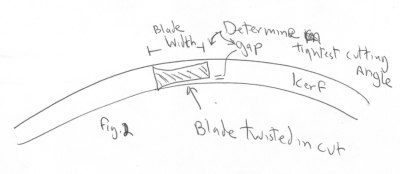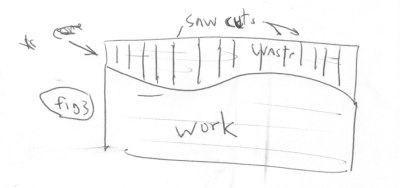|
|
|
 Joel's Blog Joel's Blog |
 Built-It Blog Built-It Blog |
 Video Roundup Video Roundup |
 Classes & Events Classes & Events |
 Work Magazine Work Magazine |
|
Hours: M-F 9:00-5:00, closed Sat,Sun Our Guarantee & Return Policy Shipping and Sales Tax Info Privacy Policy Holiday Calendar |
|
Contact Us:
Email: support@toolsforworkingwood.com Phone: 800-426-4613 or 718-499-5877 Visit Us in Brooklyn: Directions to Our Showroom © 1999-2019 toolsforworkingwood.com Powered by 01 Inc. Coded entirely in NYC |



 We got the idea for 1/8" wide bow saw blades for our turning saw when we saw the blades on
We got the idea for 1/8" wide bow saw blades for our turning saw when we saw the blades on  Another strategy that works is to cut a series of straight saw cuts perpendicular to the final curve (fig. 3) and then cut knock out the waste with a chisel. Then work the curve smooth with rasps or a spokeshave.
Another strategy that works is to cut a series of straight saw cuts perpendicular to the final curve (fig. 3) and then cut knock out the waste with a chisel. Then work the curve smooth with rasps or a spokeshave.
My 8 year old woodworking student had to to cut a curve on his project and the curve was made in 2x4 material. The tool he had to use was a jig saw with a wide blade. He had never used a jigsaw before although he did have one previous lesson on a scroll saw. I taught him the method of cutting a short distance then backing the tool up and cutting again. That way the wide blade creates its own wide path. He cut a nearly perfect, very smooth curve. Not bad for an 8 year old who has only two months of one hour lessons on a Saturday.
Every time I hear someone putting an 8 year in the shop I am thrilled. Congratulations to you on not being scared that your child is too young!!. Too many people are afraid of letting kids into the shop - even with tons of supervision.
Sadly, however - your technique would not have worked in my case as I needed both sides of the cut and did I mention that I had narrow blades around I just didn't think to you them. When I tell you I was being pretty stupid I was not exaggerating.
The smoothest radius cut comes from when you happen to find the perfect sized saw blade and can "ride" the back of the blade in the kerf - helps keep your trajectory smooth if you aren't quite perfect at steering.